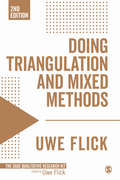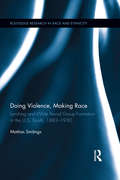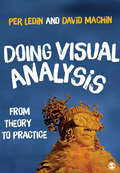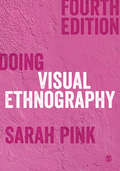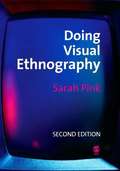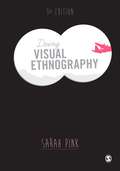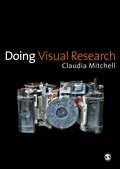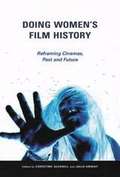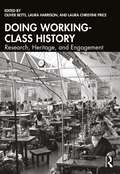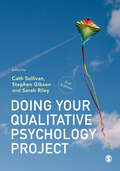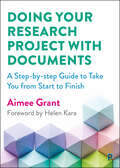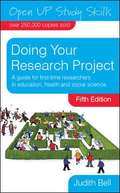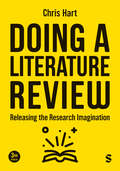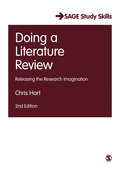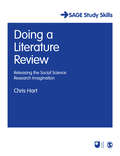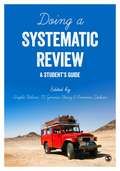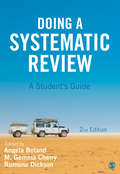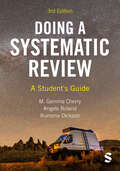- Table View
- List View
Doing Triangulation and Mixed Methods (Qualitative Research Kit #8)
by Dr Uwe FlickThis book shows you not just how to use triangulation as a strategy of quality management, but also how to use it as an approach to designing and doing qualitative research in a more comprehensive way. Flick links triangulation with current debates about using mixed methods, and outlines their potential for extending qualitative research, addressing questions such as how such research can benefit from integrating quantitative (mixed methods), or from working more generally with more than one approach (triangulation).
Doing Triangulation and Mixed Methods (Qualitative Research Kit #8)
by Dr Uwe FlickThis book shows you not just how to use triangulation as a strategy of quality management, but also how to use it as an approach to designing and doing qualitative research in a more comprehensive way. Flick links triangulation with current debates about using mixed methods, and outlines their potential for extending qualitative research, addressing questions such as how such research can benefit from integrating quantitative (mixed methods), or from working more generally with more than one approach (triangulation).
Doing Violence, Making Race (Routledge Research in Race and Ethnicity)
by Mattias SmångsThe subject of lynching has spawned a vast body of important research, but this research suffers from important blind spots and disjunctures. By broadening the scope of research problem formulation, staking out new theoretical-analytical tracks, and drawing upon recent innovations in statistical methodology to analzye newer and more detailed data, Doing Violence, Making Race offers an innovative contribution to our understanding of this grim subject matter and its place within the broader history and sociology of US race relations. Indeed, this volume demonstrates how different forms of lynching fed off and into the formation of the racial group boundaries and identities at the foundation of the Jim Crow system. The book also demonstrates that as dominant white racial ideologies and conceptions took an extremist turn, lethal mob violence against African Americans increasingly assumed the form of public lynchings, serving to transform symbolic representations of blacks into social stigma and exclusion. Finally, Smångs also explores how public lynchings were expressive as well as generative of the collective white racial identity mobilized through the southern branch of the Democratic Party, whilst private lynchings were related to whites’ interracial status and social identity concerns on the interpersonal level. The most complete and complex scholarly treatment of this grim subject to date, this enlightening volume will be of interest to undergraduate and graduate students interested in areas such as Sociology, Political Science, History, Criminology/Criminal Justice, Anthropology, American Studies, African-American and Whiteness Studies.
Doing Visual Analysis: From Theory to Practice
by David Machin Professor Per LedinVisual communication shapes our perceptions and experiences of the world. This is not only a question of photographs or video, but also the design of websites, the use of data visualization software, the branding of packaging, and even the design of buildings and furniture. Doing Visual Analysis: From Theory to Practice provides a concrete set of tools to research and analyse this wide range of visual data. Showing students how to apply the right mix of methods to their own research projects, it equips them with the skills to break down and analyse the range of contemporary visual communication. The book: Provides examples of how and where certain tools can be used in a project or dissertation Discusses the type of research questions best suited to different tools and methods Shows students how to mix approaches and use tools alongside other methods, such as content analysis or interviews Doing Visual Analysis is an essential companion for students and researchers of visual data across the social sciences.
Doing Visual Analysis: From Theory to Practice
by David Machin Professor Per LedinVisual communication shapes our perceptions and experiences of the world. This is not only a question of photographs or video, but also the design of websites, the use of data visualization software, the branding of packaging, and even the design of buildings and furniture. Doing Visual Analysis: From Theory to Practice provides a concrete set of tools to research and analyse this wide range of visual data. Showing students how to apply the right mix of methods to their own research projects, it equips them with the skills to break down and analyse the range of contemporary visual communication. The book: Provides examples of how and where certain tools can be used in a project or dissertation Discusses the type of research questions best suited to different tools and methods Shows students how to mix approaches and use tools alongside other methods, such as content analysis or interviews Doing Visual Analysis is an essential companion for students and researchers of visual data across the social sciences.
Doing Visual Ethnography
by Sarah PinkThis book is the definitive guide to understanding and doing visual ethnography. Sarah Pink’s landmark text provides you with both the critical theoretical foundations and the creative tools and techniques you need to conduct your own visual ethnography. Covering the material and the digital, and tying key concepts and ideas to real world contexts throughout, this fully updated fourth edition: Provides clear and critical guidance on research planning and ethics Discusses new and emerging technologies, including digitally connected devices and wearable cameras. Introduces contemporary methods such as futures ethnography, distance ethnography, team ethnography, and the use of documentary. Explores the latest theory and practice in photographic and video ethnography. Shows you how visual ethnography can be applied, participatory, and even interventional. A milestone in visual and ethnographic research, this book is a must-have for students and researchers across the social sciences. It is an essential invitation, and companion, to doing impactful, creative, and critical visual research.
Doing Visual Ethnography
by Sarah PinkThis book is the definitive guide to understanding and doing visual ethnography. Sarah Pink’s landmark text provides you with both the critical theoretical foundations and the creative tools and techniques you need to conduct your own visual ethnography. Covering the material and the digital, and tying key concepts and ideas to real world contexts throughout, this fully updated fourth edition: Provides clear and critical guidance on research planning and ethics Discusses new and emerging technologies, including digitally connected devices and wearable cameras. Introduces contemporary methods such as futures ethnography, distance ethnography, team ethnography, and the use of documentary. Explores the latest theory and practice in photographic and video ethnography. Shows you how visual ethnography can be applied, participatory, and even interventional. A milestone in visual and ethnographic research, this book is a must-have for students and researchers across the social sciences. It is an essential invitation, and companion, to doing impactful, creative, and critical visual research.
Doing Visual Ethnography Second edition
by Sarah PinkFollowing the success of the First Edition, this fully revised and updated Second Edition of Doing Visual Ethnography explores the use and potential of photography, video, and hypermedia in ethnographic and social research. It offers a reflexive approach to theoretical, methodological, practical, and ethical issues of using these media now that they are increasingly being incorporated into field research. Author Sarah Pink adopts the viewpoint that visual research methods should be rooted in a critical understanding of local and academic visual cultures, the visual media, and technologies being used and the ethical issues they raise.
Doing Visual Ethnography: Images, Media And Representation In Research
by Sarah PinkEssential reading for anyone wishing to engage with images, technologies and society, Doing Visual Ethnography is a milestone in ethnographic and visual research. The third edition of this classic text includes new chapters on web-based practices for visual ethnography and the issues surrounding the representation, interpretation and authoring of knowledge with the rise of digital media. The book provides a foundation for thinking about visual ethnography and introduces the practical and theoretical issues relating to the visual and digital technologies used in the field. Drawing upon her original research and the experiences of other ethnographers, Sarah Pink once again challenges our understanding of the world and sets new agendas for visual ethnography by: Helpfully illustrating key concepts within real world contexts Introducing examples from both analogue and digital media Exploring material and electronic texts Setting out the shift towards applied, participatory and public visual scholarship. This book is a must-have for students and researchers across the social sciences who are interested in incorporating audiovisual media into their research practice.
Doing Visual Research
by Claudia MitchellDoing Visual Research offers an innovative introduction to the use of photography, collaborative video, drawing, objects, multi-media production and installation in research. Claudia Mitchell explains how visual methods can be used as modes of inquiry as well as modes of representation for social research. The book looks at a range of conceptual and practical approaches to a range of tools and methods, whilst also highlighting the interpretive and ethical issues that arise when engaging in visual research. Claudia Mitchell draws on her own work in the field of visual research throughout to offer extensive examples from a variety of settings and with a variety of populations. Topics covered include: • Photographs and memory work studies • Video and social change • Participatory archiving with drawings and photos • Working with images/Writing about images • Can visual methods make a difference? From practice to policy Doing Visual Research takes an interdisciplinary approach to the subject of visual research, producing a practical introduction to the subject that will be of great use to students and researchers across the social sciences, and in particular in education, communication, sociology, gender, development, social work and public health.
Doing Women's Film History: Reframing Cinemas, Past and Future
by Julia Knight Jane Gaines Christine Gledhill Monica Dall'AstaResearch into and around women's participation in cinematic history has enjoyed dynamic growth over the past decade. A broadening of scope and interests encompasses not only different kinds of filmmaking--mainstream fiction, experimental, and documentary--but also practices--publicity, journalism, distribution and exhibition--seldom explored in the past. Cutting-edge and inclusive, Doing Women's Film History ventures into topics in the United States and Europe while also moving beyond to explore the influence of women on the cinemas of India, Chile, Turkey, Russia, and Australia. Contributors grapple with historiographic questions that cover film history from the pioneering era to the present day. Yet the writers also address the very mission of practicing scholarship. Essays explore essential issues like identifying women's participation in their cinema cultures, locating previously unconsidered sources of evidence, developing methodologies and analytical concepts to reveal the impact of gender on film production, distribution and reception, and reframing film history to accommodate new questions and approaches. Contributors include: Kay Armatage, Eylem Atakav, Karina Aveyard, Canan Balan, Cécile Chich, Monica Dall'Asta, Eliza Anna Delveroudi, Jane M. Gaines, Christine Gledhill, Julia Knight, Neepa Majumdar, Michele Leigh, Luke McKernan, Debashree Mukherjee, Giuliana Muscio, Katarzyna Paszkiewicz, Rashmi Sawhney, Elizabeth Ramirez Soto, Sarah Street, and Kimberly Tomadjoglou.
Doing Working-Class History: Research, Heritage, and Engagement
by Laura Harrison Oliver Betts Laura Christine PriceEconomic and political uncertainty has brought the language of class – especially discussion of the working class – to a broad audience across scholarship and social debate. This introductory volume shows how the history of the working class has, is, and can be researched, written, and represented.The book is structured in three parts: perspective, context, and application. Each offers an introduction to both classic historiography and new ideas and methodologies. With chapters covering a span of the years c.1750–present, the book focuses on three essential questions: What is working-class history and what should it become? What can a focus on working-class history reveal? What are the possibilities of this research in the university classroom, the heritage world, and beyond? Doing Working-Class History will appeal to students and scholars of working-class history, whether relative newcomers to the field or veteran researchers interested in new approaches and material. It will also be of interest to local and family historians, museum and heritage professionals, and general readers.
Doing Your Qualitative Psychology Project
by Cath Sullivan Stephen Gibson Sarah RileyEmbarking on your own psychology research? This book equips you with the skills you need to complete a qualitative project confidently. The book takes you through the process of doing your project, showing how to plan and execute each stage. It helps you make good decisions about key steps such as choosing a research topic, designing your project, doing ethical research and writing up. This second edition: Offers a host of learning features including ‘in a nutshell’ summaries, further reading, activities and top tips to help you develop your understanding and skills. Devotes more space to the important topics of project planning and doing ethical research with a new chapter on each. Enables you to critically evaluate your work, helping you conduct high-quality research. Discusses student success stories and cautionary tales illustrating, from start to finish, how qualitative projects are done in the real world. This is the perfect guide for undergraduates doing a final project or dissertation, and postgraduates who are relatively new to qualitative research.
Doing Your Qualitative Psychology Project
by Cath Sullivan Stephen Gibson Sarah RileyEmbarking on your own psychology research? This book equips you with the skills you need to complete a qualitative project confidently. The book takes you through the process of doing your project, showing how to plan and execute each stage. It helps you make good decisions about key steps such as choosing a research topic, designing your project, doing ethical research and writing up. This second edition: Offers a host of learning features including ‘in a nutshell’ summaries, further reading, activities and top tips to help you develop your understanding and skills. Devotes more space to the important topics of project planning and doing ethical research with a new chapter on each. Enables you to critically evaluate your work, helping you conduct high-quality research. Discusses student success stories and cautionary tales illustrating, from start to finish, how qualitative projects are done in the real world. This is the perfect guide for undergraduates doing a final project or dissertation, and postgraduates who are relatively new to qualitative research.
Doing Your Research Project with Documents: A Step-by-Step Guide to Take You from Start to Finish
by Aimee GrantStudents and researchers have an abundance of materials and sources available to them via the internet for use in their projects. However, there is little practical guidance available on the fundamentals of performing qualitative research with documents. This valuable book enables readers to undertake high-quality, robust research using documents as data. Encouraging critical consideration of research design, the book guides readers step-by-step through the process of planning and undertaking a research project based on documentary analysis. It covers selecting a research topic and sample through to analysing and writing up the data. The book includes: • a wealth of case studies demonstrating how lessons can be applied in practice; • summary boxes and suggestions for further reading in each chapter to guide learning; • helpful online resources to facilitate designing your own research. Accessible and comprehensive, this book will be invaluable for both students and researchers alike who are new to documentary analysis. All the Resources included in this book are available to download on the book’s webpage at https://policy.bristoluniversitypress.co.uk/doing-your-research-project-with-documents/online-resources. Look for the Online Resources logo throughout the book.
Doing Your Research Project: A guide for first-time researchers in education, health and social science
by Judith BellStep-by-step advice on completing an outstanding research project. Research can be daunting, particularly for first-timers, but this indispensable book provides everything you need to know to prepare for research, draft and finalise a methodologically sound and well-written report or thesis, plus it warns you of potential pitfalls to prevent you wasting time on false trails. This new edition of Doing Your Research Project has been thoroughly updated and includes: Wider coverage of research ethics Clear guidelines on the differences between different types of research project New coverage of "Research diaries" New sources in further reading plus more information on internet research and the use of electronic resources Coverage of the latest information on plagiarism More examples to highlight key issues This bestselling book is an essential resource to help establish good practice for beginner researchers embarking on undergraduate or postgraduate study, and for professionals in such fields as social science, education, and health.
Doing a Literature Review: Releasing the Research Imagination
by Chris HartElevate your research with the Third Edition of this classic guide. Master the "what," "how," and "why" of literature reviews and fully realise the potential of your scholarly work and evidence-based practice. By taking you on an intellectual journey, this book helps you streamline the process of searching, managing workflows and structuring different types of literature reviews. This is a totally revised and updated classic text on Literature reviewing for the AI age. It includes: ·Comprehensive explanation of the different types of review, evidence, and evaluation. ·New and more contemporary examples illustrating the many ways of conducting a literature review, including how to exploit the latest developments in AI apps. ·A "core skills" framework to help you turn your research experience into employability. ·A critical thinking focus that will not only help enhance your creativity, thinking and practical skills but also stimulate your intellectual curiosity and engagement with your research. In combining a critical, philosophical approach with an expertly selected body of practical examples, the Third Edition of Chris Hart′s landmark retains the strength of the original and successful previous editions, while helping researchers attain higher levels of knowledge and skills.
Doing a Literature Review: Releasing the Research Imagination
by Chris HartElevate your research with the Third Edition of this classic guide. Master the "what," "how," and "why" of literature reviews and fully realise the potential of your scholarly work and evidence-based practice. By taking you on an intellectual journey, this book helps you streamline the process of searching, managing workflows and structuring different types of literature reviews. This is a totally revised and updated classic text on Literature reviewing for the AI age. It includes: ·Comprehensive explanation of the different types of review, evidence, and evaluation. ·New and more contemporary examples illustrating the many ways of conducting a literature review, including how to exploit the latest developments in AI apps. ·A "core skills" framework to help you turn your research experience into employability. ·A critical thinking focus that will not only help enhance your creativity, thinking and practical skills but also stimulate your intellectual curiosity and engagement with your research. In combining a critical, philosophical approach with an expertly selected body of practical examples, the Third Edition of Chris Hart′s landmark retains the strength of the original and successful previous editions, while helping researchers attain higher levels of knowledge and skills.
Doing a Literature Review: Releasing the Research Imagination (SAGE Study Skills Series)
by Chris HartThe ultimate guide to the ‘what’, ‘how’ and ‘why’ of literature reviewing, the second edition of the classic text shows how the literature review will unlock the full potential of one's research with: A thorough exploration of the literature review process from start to finish Two brand new chapters explaining the different types of review and evidence and evaluation Extended examples that show you how to apply key techniques and procedures A new ‘core skills’ framework to help you turn your research experience into employability A critical thinking focus that will help you construct convincing arguments and improve your research decisions In combining a critical, philosophical approach with an expertly selected body of practical examples, the Second Edition of Chris Hart's landmark text provides both the intellectual understanding and the technical skills required to produce sophisticated, robust literature reviews of the very highest standard. SAGE Study Skills are essential study guides for students of all levels. From how to write great essays and succeeding at university, to writing your undergraduate dissertation and doing postgraduate research, SAGE Study Skills help you get the best from your time at university. Visit the SAGE Study Skills hub for tips, resources and videos on study success!
Doing a Literature Review: Releasing the Research Imagination (SAGE Study Skills Series)
by Chris HartThe ultimate guide to the ‘what’, ‘how’ and ‘why’ of literature reviewing, the second edition of the classic text shows how the literature review will unlock the full potential of one's research with: A thorough exploration of the literature review process from start to finish Two brand new chapters explaining the different types of review and evidence and evaluation Extended examples that show you how to apply key techniques and procedures A new ‘core skills’ framework to help you turn your research experience into employability A critical thinking focus that will help you construct convincing arguments and improve your research decisions In combining a critical, philosophical approach with an expertly selected body of practical examples, the Second Edition of Chris Hart's landmark text provides both the intellectual understanding and the technical skills required to produce sophisticated, robust literature reviews of the very highest standard. SAGE Study Skills are essential study guides for students of all levels. From how to write great essays and succeeding at university, to writing your undergraduate dissertation and doing postgraduate research, SAGE Study Skills help you get the best from your time at university. Visit the SAGE Study Skills hub for tips, resources and videos on study success!
Doing a Literature Review: Releasing the Social Science Research Imagination (SAGE Study Skills Series)
by Chris HartReviewing the literature for a research project can seem a daunting, even overwhelming task. New researchers, in particular, wonder: Where do I start? What do I do? How do I do it? This text offers students across the social sciences and humanities a practical and comprehensive guide to writing a literature review. Chris Hart offers invaluable advice on how to: search out existing knowledge on a topic; analyse arguments and ideas; map ideas, arguments and perspectives; produce a literature review; and construct a case for investigating a topic. Doing a Literature Review contains examples of how to cite references, structure a research proposal and present a Master's thesis. It is published as a Set Book for The Open University Postgraduate Foundation Module (D820) The Challenge of the Social Sciences. `I have been waiting for this book for five years. It sets out a number of important dimensions involved in the process of literature review and by clear signposting, diagrams, and examples will help the student to carry out her or his review more systematically. Learning how to carry out a literature review has always entailed the experiential. While this is a the best way of learning, it is only so providing that learning actually takes place during the experience (or by reflection afterwards). This book makes explicit those dimensions which could remain implicit or even missed by the student as they wade through all those books, papers, articles, and print-outs' - Kevin Maguire, Nottingham Trent University SAGE Study Skills are essential study guides for students of all levels. From how to write great essays and succeeding at university, to writing your undergraduate dissertation and doing postgraduate research, SAGE Study Skills help you get the best from your time at university. Visit the SAGE Study Skills website for tips, quizzes and videos on study success!
Doing a Systematic Review
by Angela Boland M. Gemma Cherry Rumona DicksonIf you are a Masters or a PhD student conducting a systematic review for your dissertation or thesis, then this is the book for you! Written by an expert team of authors with years of experience in conducting systematic reviews and supervising students doing systematic reviews, the book provides a roadmap to guide you through the process. The book addresses the following questions: - What's the best way to manage my review? - How do I formulate an appropriate review question? - How do I develop my search strategy? - How do I get started on data extraction? - How do I assess the quality of the studies I'm using? - How can I analyse and synthesise my data? - How should I write up the discussion and conclusion sections of my dissertation or thesis? - Where should I publish my data? Throughout the book, the authors make extensive use of questions posed by real students when carrying out reviews to help you through some of the challenges you may face. Like a team of supervisors in your pocket, this book will provide you with the tips and tools for a successful dissertation.
Doing a Systematic Review: A Student's Guide
by Angela Boland Rumona Dickson Gemma CherryWritten in a friendly, accessible style by an expert team of authors with years of experience in both conducting and supervising systematic reviews, this is the perfect guide to using systematic review methodology in a research project. It provides clear answers to all review-related questions, including: How do I formulate an appropriate review question? What’s the best way to manage my review? How do I develop my search strategy? How do I get started with data extraction? How do I assess the quality of a study? How can I analyse and synthesize my data? How should I write up the discussion and conclusion sections of my dissertation or thesis?
Doing a Systematic Review: A Student's Guide
by Angela Boland Rumona Dickson Gemma CherryWritten in a friendly, accessible style by an expert team of authors with years of experience in both conducting and supervising systematic reviews, this is the perfect guide to using systematic review methodology in a research project. It provides clear answers to all review-related questions, including: How do I formulate an appropriate review question? What’s the best way to manage my review? How do I develop my search strategy? How do I get started with data extraction? How do I assess the quality of a study? How can I analyse and synthesize my data? How should I write up the discussion and conclusion sections of my dissertation or thesis?
Doing a Systematic Review: A Student′s Guide
by Angela Boland Rumona Dickson Gemma CherryCompleting a systematic review and unsure where to start or what path to take? Set out on your journey confidently with this practical guide written by a team of experienced academics. With a friendly, accessible style, the book covers every step of the systematic review process, from planning to dissemination. This book will help you to: • Work with qualitative, quantitative and mixed methods data • Understand the how-to of systematic reviews with a range of real-life examples and case studies • Learn from students who have been in your shoes with FAQs taken from actual supervision meetings. This book will not only support you to overcome common challenges and pitfalls, it will give you the knowledge and skills to produce an excellent review and you might even enjoy the journey! Alongside updated examples and case studies, this edition also includes two new chapters to help you write and register your review protocol and understand and synthesise data from correlational and experimental studies. The book is accompanied by an online guide for teaching, including videos, example documents, further reading, software recommendations and weblinks.
